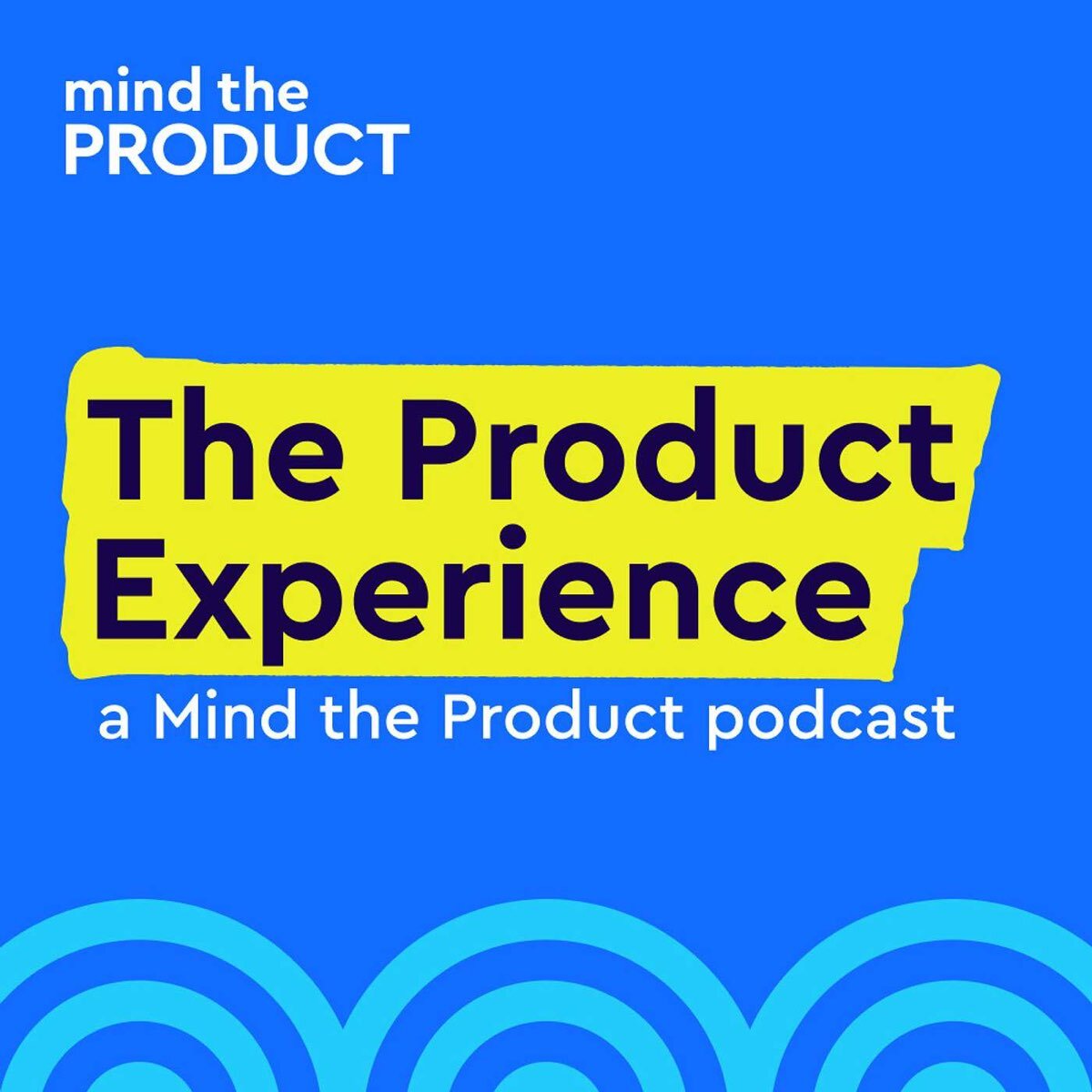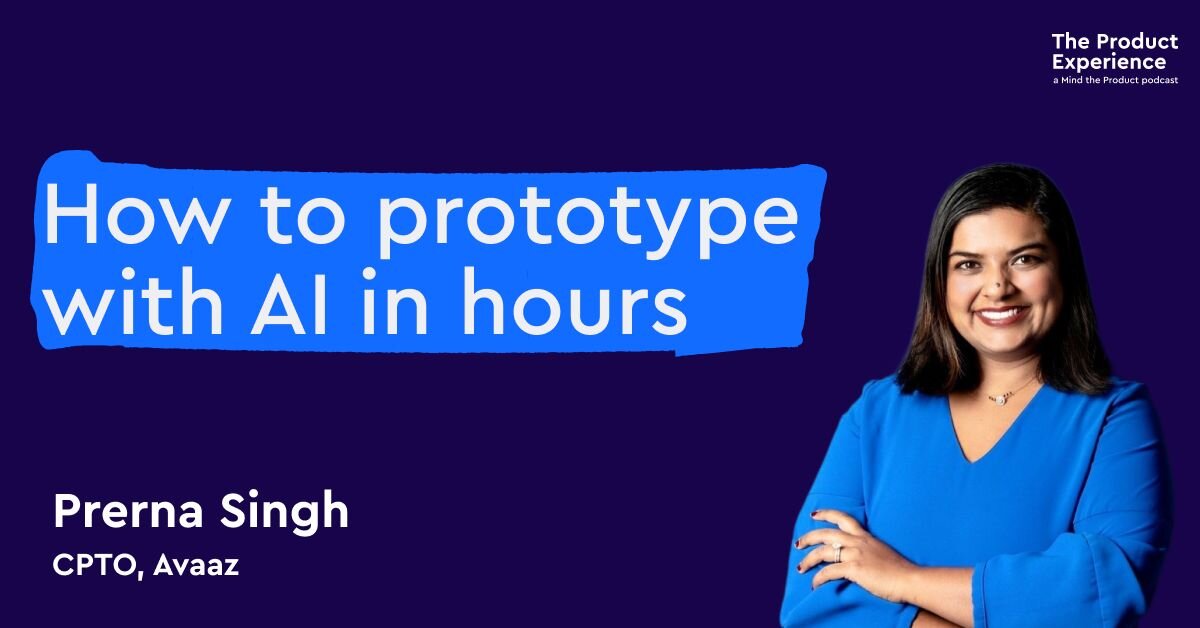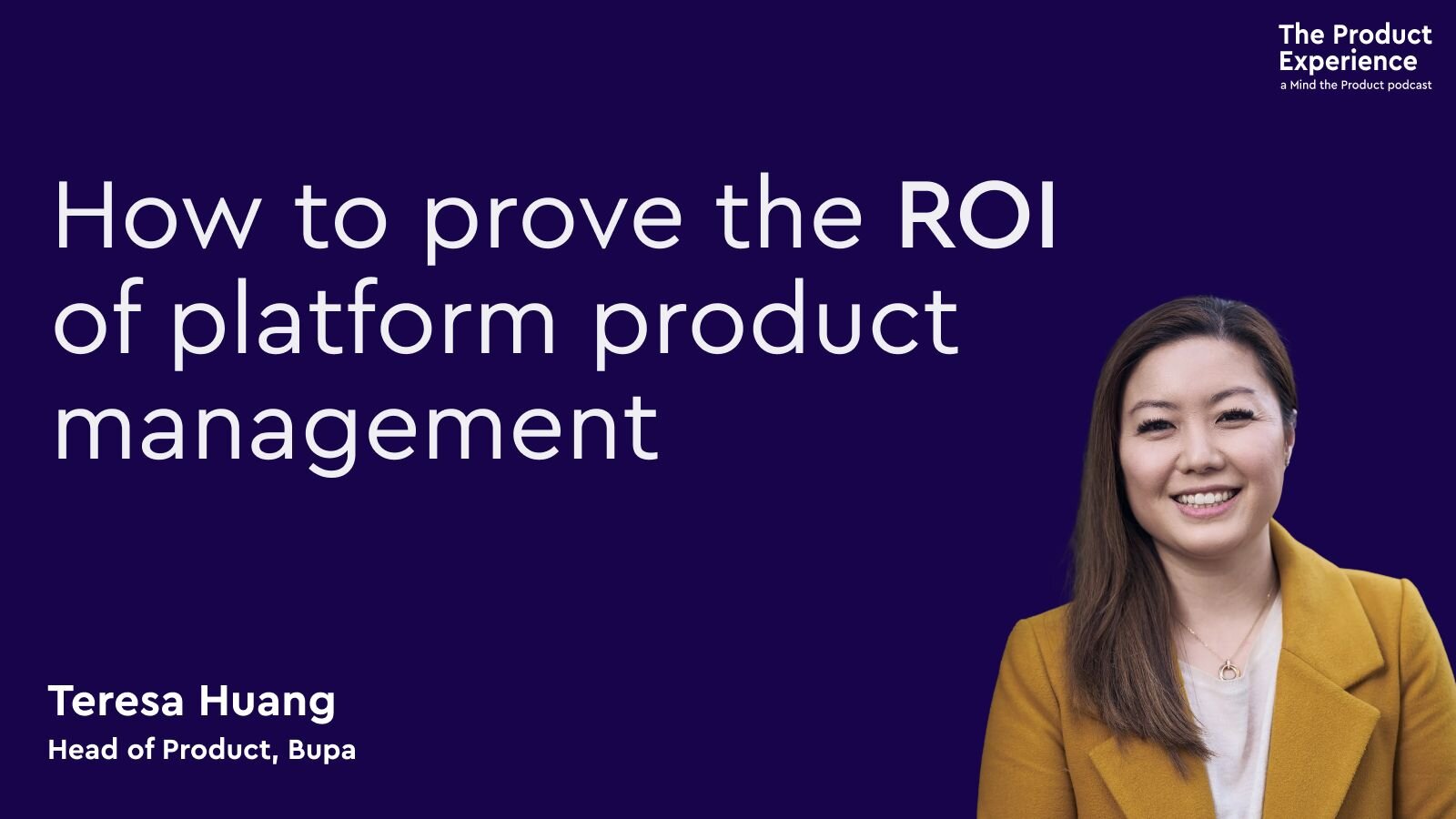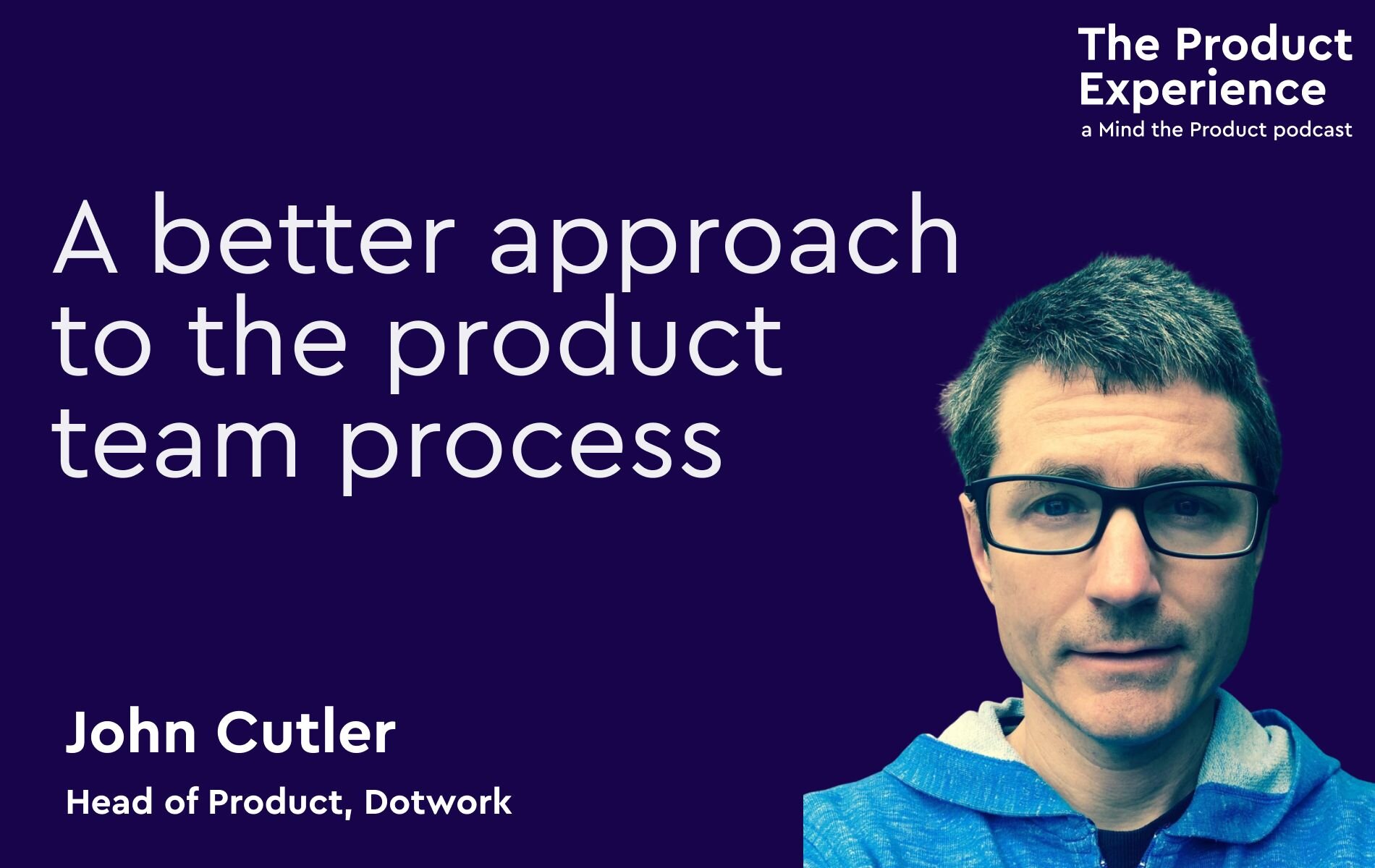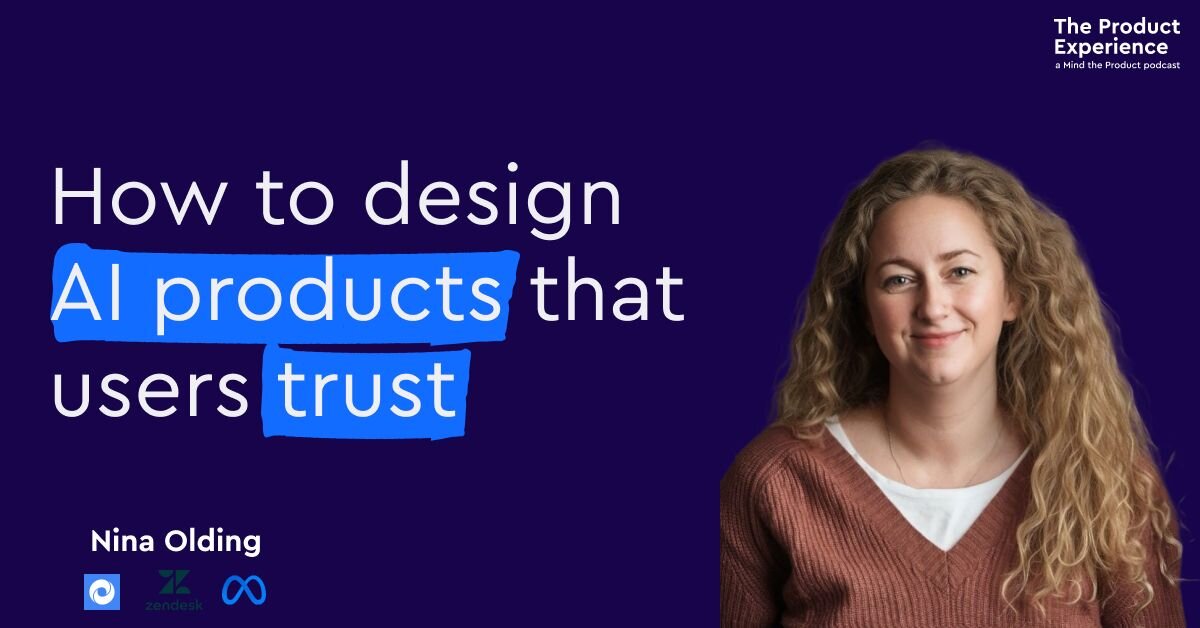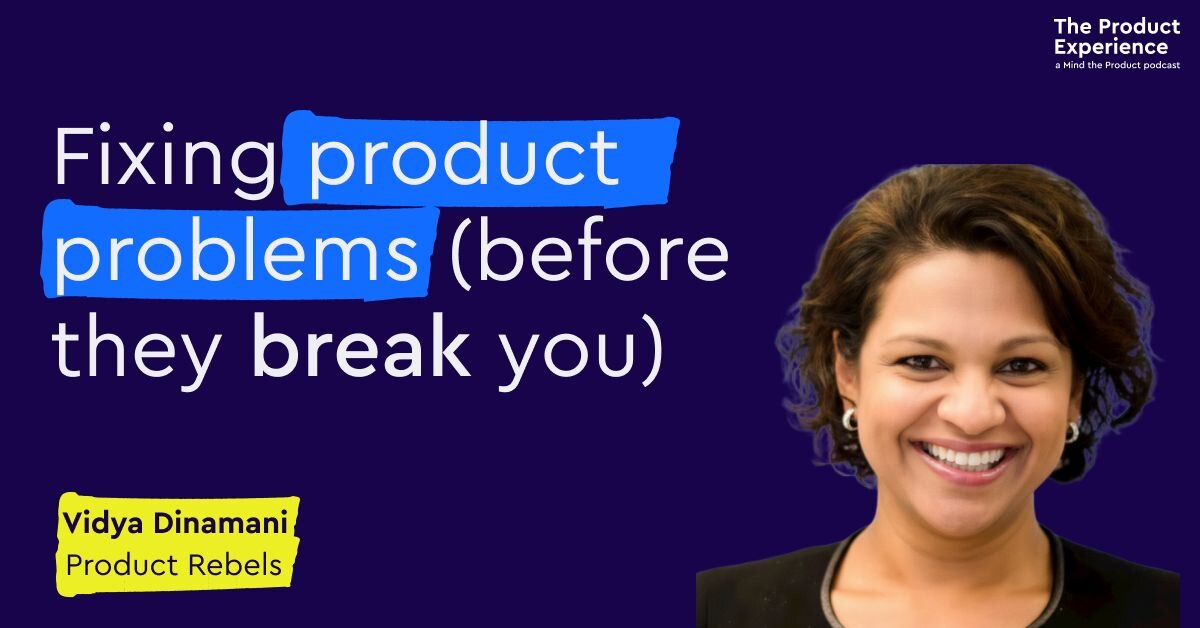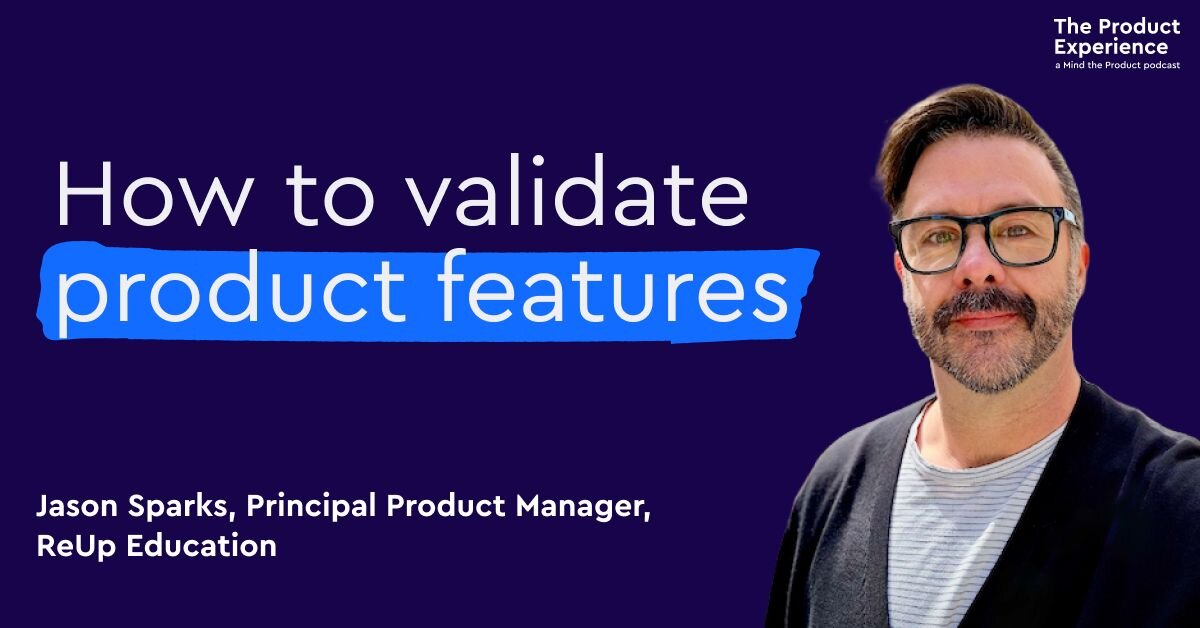- 0:00 People-first product leadership
- 12:42 Developing a people-first approach
- 17:10 Balancing product focus and people involvement
- 23:55 Creating a people-first culture in organisations
Featured Links: Follow Diana on LinkedIn | Diana's website | Try Diana's 'People-First Product Leadership' course at Maven | Diana's profile at Substack
Episode transcript
Lily Smith :
Happy New Year and welcome back to the product experience. This year we are kicking off with People First product leadership, and we have Diana Stepner who's the head of product at the Chan Zuckerberg initiative. So for more inspiration and to start your year on the right foot, let's get rolling. Visit mindtheproductcom to catch up on past episodes and discover loads of free resources to help you with your product practice. You can also find more information about mind, the products conferences and their great training opportunities happening around the world and online. Hi, diana, so great to speak to you today. How are you doing?
Diana Stepner:
Wonderful, yeah, so thrilled to be speaking to you both today as well. It's in San Francisco, it is a very rainy day, so I feel like I am over in the UK with you both, so I'm very excited to have the conversation.
Lily Smith :
How did you know it was raining in the UK? You have like psychic abilities or something.
Diana Stepner:
My husband spoke to his mother yesterday. It was raining so I just kind of went with the same.
Lily Smith :
It's a safe assumption and we're going to be talking today about People First product leadership. But before we get stuck into our topic, it would be great if you could give our listeners a quick intro to who you are and what you're doing in product these days.
Diana Stepner:
Yeah, so I'm Diana Stepner. I've been in product for a very long time. I went through a lot of steps and turns and twists, I think, just as a typical product person does. You know, we all have our own unique paths. For me it was I worked at a startup and it was done by a whole bunch of engineers and the customers were marketers and they just didn't really get the engineering terminology that kept appearing in the product and so eventually went back to school, got a degree in human-computer interaction and started at Salesforce working in the product group. But I was a user experience researcher. I did UXR and just love doing it. Love talking to you know the customers, the prospects, understanding how we can make the product better. What were their, you know, pain points, all those opportunities, and I kept turning over these ideas, you know, to the product folks and I'm like why, why couldn't I do this? Why couldn't I be a product manager and take these ideas and bring them to life? And so my my next job was as a product person in the UK. I moved to the UK and was there for about 12 years and just started my product journey. You know, after that experience and user experience research, working along with us, the product managers.
Lily Smith :
So been in product ever since nice, and what do you do these days?
Diana Stepner:
so I am in the product team at the Chan Zuckerberg initiative. So there's a couple different facets to the Chan Zuckerberg initiative. So I am in the education side, nice.
Lily Smith :
And for those who haven't heard of that, what does it do?
Diana Stepner:
it's a philanthropy that was started by Priscilla Chan and Mark Zuckerberg, and so there's a number of different facets to it. The two main facets focus on science as well as education. So I'm in the education group and we look at K-12 and opportunities to bring new technology developments to market in a way that would have an impact in areas that typically may not get addressed because there might not be a revenue opportunity. But as a philanthropy, we can focus more on impact and not be as concerned about revenue. So we look at how to raise the floor for individuals to have access to education for all, as well as how to raise the ceiling for individuals who already have access to education but are looking for for more opportunities as they're growing and developing to to realize who they want to be.
Lily Smith :
Amazing. That sounds really interesting and I would love to get stuck into that, but today we're going to be talking about something slightly different. So our topic is people first. Product leadership and I know you run a course on Maven on the subject, but before we get stuck into the details, tell us a little bit about what that means to do product leadership, people first.
Diana Stepner:
Yeah, and it's. There's often this triad of characteristics that product people will reference. It's a combination of product and people and process, and it's some organizations. The product comes first. That's what you focus on, that is everyone's reason for being, and just everyone is dedicated to the product. There are other organizations that are much more process heavy. That is how they determine what to do, the priorities, how to approach things. It's very process oriented. And then there are other organizations that put the people first and look at ways to get the optimal impact and outcome from the individuals, and so that that's where I fall. I believe if you put the people first in that combination of people, product and process, you'll always get amazing products or the best potential products, just because you're looking at the opportunities for people to be true to themselves and to contribute their expertise and to learn, and I think that shows up very well in the product and how it develops and thus process. You need some, but it's always something that we want to manage and not have it be overwhelming. And if the people are happy and are working together effectively because they all feel that that's an opportunity for them to grow and to trust each other and to be collaborative, then you may not need as much process as you would otherwise in an organization that put the people kind of at the end of the train.
Randy Silver:
Dana. I'm curious. Everyone thinks they're good at this. Everyone thinks they're good at you know, anyone who's a manager thinks they're good at managing people. Well, not everyone, but quite a few. What does it actually mean to be good at it, though? To be putting people first, as opposed to just thinking you do?
Diana Stepner:
Yeah, and I'd say some organizations actually don't think that way. They think that the people are there just in service of the business and so you can put those people anywhere and just have them perform, and I don't think that's the right way to get the most out of individuals, to truly find those unique characteristics that make us all individuals. I think there needs to be more thought in regards to what we do and how we do it and the roles that we may take on in a business. But I've seen organizations which are like they're people, we can put them anywhere and if they can't do it, so be it. But they're not thinking about what the people want, where they want to go in their career, how to best enable them to gain that experience in the organization, and when we really think about the impact people want to have, not just for the customers or for the business, but also for themselves, I think you get much more potential from the individuals. They're much more committed, they're much more excited to show up every day and I think that is something that, even though people think they're doing it, they truly are doing it in service, often of just revenue and seeing the people as you can, just kind of, as I said, put them anywhere and they will perform, and I've found that not to be the case. People are great and they'll try to be adaptable, but to really get the best out of the people, you need to think about them as people first and figure out what you can do to help them shine.
Lily Smith :
And you said some people you've seen some people think that they're doing this but they're actually not doing it. So when I hear that I'm thinking, oh yeah, I put people first. But now I'm like, oh no, do I put people first? Like what's your first kind of piece of advice to people to assess whether you really are working from a people first position in product leadership?
Diana Stepner:
Yeah, I think a lot of it. A lot of it comes down to trust and collaboration. A lot of organizations, when you ask them, you know, how do you deal with conflict or how do you deal with differences in prioritization? They will often say, oh, you know, the highest level person makes the decision and that often is a good sign that the individuals may not be on top of mind that there's some other approach that the organization has to being effective. And in those organizations where I've seen people first, the people trust each other, they collaborate. It's not a competition. They're there to be able to help each other succeed in support of the customer and the business. But you'll find organizations where it is competitive, where it is rather cutthroat, and even though the individuals may feel that that is an environment where they are thinking about their employees, when you take a step back and you think about how they make decisions or how do they approach partnerships or opportunities, it's often just again seeing people as individuals. You can just cut and paste into any scenario without really thinking about. You know what the person wants to be, the skills that they want to develop where they are in their career and the opportunities that will help them progress. They'll oftentimes just again put the business first. They'll do all the decision making, push it down, and people don't have the opportunity to really develop because they're not given that autonomy to be and become the people that they want to be, not just on a personal level, but on a career level too. How did you learn all?
Randy Silver:
this? Did this come naturally to you, or were you in situations where maybe it wasn't quite so nice and you had to react to it?
Diana Stepner:
or yeah, I worked overseas for a really long time and doing so I encountered a lot of different cultures and a lot of different types of people, and I found the most effective way to bring those people together was to treat them as people and to really listen to them, to understand what it was that they wanted to get out of the partnership or the consulting agreement or the application that they're building. And so to me it was a way to better understand the different cultures and the individuals that I was working with, to really get to know them as people, so that I could bring those different cultures together and enable a project to be built in that collaboration. So it wasn't something that was just instinctive to me and just magically happened. It was something that I learned over my career, just working all around the world and just being able to look and understand and appreciate the nuances that are people and to be able to bring those amazing characteristics together, to have people work together effectively and to develop a partnership to ideally introduce a feature or product or consulting project that could make everything better, not just for the customers or for the business, but also for the people too.
Lily Smith :
And, diana, I love to hear stories from the front line. You know of specifics, like of how that's kind of manifested for you. Do you have anything that you could share with us of like a time where you suddenly realise that you weren't being people first and you changed your approach, or anything like that that we could learn from?
Diana Stepner:
Yeah, I think when I look back over my career, there are a couple of instances that come to mind, and one was at a startup that I was at for a very short period of time and instead of, you know, people working together, we had to develop like a 60 page PRD before anybody would talk to each other. And that really stood out to me as a point in time where I realized, you know, the business had these amazing people, but they didn't feel like they could talk to each other unless a document was the the main focus. And that was fascinating to me. And, like you have these amazing people, they have excellent insight. We have, you know, the opportunity to speak to customers, but the only way that this meeting is going to happen is if we have a 60 page document that will immediately be out of date as soon as we have this meeting. And so that that really stood out to me as a time where people weren't first, that the process was first, and it resonated with me as something that really should be changed and hopefully other organizations learned that too. You now see more lean approaches than that. You know really extensive PRD, so I think others may have encountered it too. The other facet of it is, you know, again, I've worked, you know, in different parts of the world and you know, in the US we tend to be quite blunt. In other countries, folks, you know, will say yes to everything, and then you need to encourage them to really tell you what you're thinking. Other places, they just, you know, kind of talk over each other, and so it really helped me to get to understand the different cultures, the nuances, and then to bring teams together in a way that people had a voice, even if you, you know, may needed to tease it out a bit, depending on the culture, just to be able to ensure that everybody had the opportunity, you know, to speak up and have their value heard. And that was something that, just again, as I traveled and I worked around the globe, it was important because you had a much more effective working environment when people really feel that they they were heard and listened to and represented.
Randy Silver:
Danyana you talked about earlier. You talked about some companies being people-led, some people being product or process-led. I've also have a friend who talks about leading his company through wartime and peacetime, which are metaphors I hate, but I understand what he, what he's getting at with it. I'm curious. You know this is something that, as you've gone through your career, you found it's worked for you and the teams you lead. Does this work for everyone, though it is, you know, everyone's different. What? What do you advise when people are trying to find their own voice or their own style?
Diana Stepner:
Yeah, and I think, exactly as you put it, it's finding your own voice in your own style, and some individuals are very happy to be all about you know the revenue, all about you know the product delivery and are very happy just to have that be the thing that everyone focuses on, and in some organizations, that that is just the way they they work and it's what you sign up for, it's what's expected of you and so, no, I don't think it's something that feels natural or feels right to everyone, and so it is important to think about what's. You know what drives you. Are you driven by you know just that delivery? Are you driven by the structure? Are you driven by you know the people, and I think it's an important thing to for people to to think about. You know what, what motivates them? You know every single day. I have worked with a lot of product people who are like I just I just want to release a product, that that's all I want to do, and I think that's brilliant just for me. I found better impact, better outcomes when I've helped people to realize you know what they bring to the table and how much better the product and the outcome could be if they worked effectively or collaboratively with other people, as opposed to just thinking about the delivery and and not considering the person you'll often hear about. You know the missionaries versus the mercenaries, and so they're like you said. There are a lot of different analogies that people play through, but again, just in my experience, you get better impact, you get better outcomes when you really consider what drives and motivates the people who are involved and for those people who are generally more kind of product or process focused, what advice do you give to to try and get more on the side of the?
Lily Smith :
the people behind you know that make up the team that are working on the product, because I guess that that will let you say it comes much more naturally to some than others, and some will come quicker to it than others. So are there any shortcuts or hacks, or or is this just a case of practice and practice?
Diana Stepner:
Yeah, I think the product side is probably the most natural, because, as a product person, you think about the customer and you really want to get into the customer's mindset to be able to understand the reason that they're seeking that product, the job to be done, the output or outcome that's being sought. And so, as we instinctively think about the customer, I think it's a natural adjacency to think about the people that you're working with on a day-to-day basis to be able to deliver that product. And if you start to think of the people as people who have good days and bad days and just have all those unique characteristics, if you start to work together effectively as a team that has autonomy and is all driving towards the best outcome that's possible, I think the product can be better. And so it's applying those principles that you already put into thinking about the customer, to think about your colleagues too, and how do you better understand them, and to put that into practice when you're working together. The process piece is probably you know it is related to I think they all come together very nicely Often the process people that I work with or have seen they're trying to hit a date, they're trying to hit an output, and when you think about the people and how they work and how best they work, you can often then meet those milestones or deliverables that you're aiming for. And so, again, by thinking about what will get you to that process that you have in place, what will make that as efficient as possible, if you think about how the people are going through it, chances are it's going to be much smoother than if you disregard the people facet of it.
Randy Silver:
I'm curious, tanya, about things that can go wrong. You know, I've seen places where people think being people first means just saying yes to everything and taking servant leadership to an extreme. Is that a good thing, or is that where you're going with this, or what kind of mistakes do you see people make?
Diana Stepner:
Yeah, I mean I've heard the phrase servant leadership, similar to what you shared before. It's not a phrase that I am necessarily a fan of. I'm not there to be that type of person for my team. I'm there more to empower them, to help them find their voice and to be more comfortable in their voice and in doing that. That doesn't mean that I shy away from decisions. It doesn't mean that I shy away from bringing people together. It doesn't mean I shy away from those tricky conversations. But I do believe that if you give people autonomy and help them to be empowered so that they feel that they can make a decision and they can try and learn and experiment, I think you're creating a culture where people feel more comfortable to speak their minds and to do so in a way that's respectful and that, to me, has had the best outcomes, where people are honest and work together as opposed to putting up a mask and just trying to fit into a mold.
Randy Silver:
There was a period of time where everyone was experimenting or adopting radical candor, and people took that to mean different things as well. Where does that fit into all this?
Diana Stepner:
Yeah, it's a great question and a great point. There are extremes that people have taken radical candor. I've seen in some organizations where they're like I can say anything I want about anything at any time, and I think that's probably pretty extreme. There are people that you're speaking to and I think it's very important to understand the impact your words could have on that individual or those individuals. So I don't think you can disregard the human. To have radical candor be effective, I think you need to have empathy for the individual that you're speaking to and be able to put forward the words, what you want to say, in a way that helps the individual to understand the point you're making, instead of just speaking out and disregarding that you're talking to a human and just not caring what reaction or how your words will hit them.
Lily Smith :
And I guess, kind of on a similar note, if you're leading a team of product people and you're kind of trying to lead with a very people first approach, if you're finding resistance or you're coming up against kind of challenge in some of that from a member of your team who perhaps isn't kind of open to that kind of, because it can be quite a sort of you know, you have to be quite vulnerable, I think in some of those discussions and you have to be very sort of open to having those discussions. Is that a sign that the that relationship is not going to work and maybe that person needs to move on or you need a different approach. Or, you know, have you come across that before or what's your experience?
Diana Stepner:
Yeah, I think any type of organization, it takes time for people to gel and so when you you know, through onboarding for example, you have the opportunity to introduce the culture to new individuals. I think that really helps to set the stage around how people interact, the expectations that are placed on individuals. So I think right from the beginning of joining a company you have an opportunity to help people you know, understand how to work effectively with others. But if you want to go even earlier, I mean thinking about interviewing or the types of companies that you want to work at. I mean, some of the questions that are given people to ask is you know how are decisions made, how are mistakes treated? When was the last time that a goal was not met and what happened? And so helping to get an understanding of those, those awkward moments that happened to all of us. How does a company deal with that? Do they, you know, tarnish the individual for whatever reason? Do they hide from mistakes? Do they not feel that you know they could have had a conversation to talk about the learnings, as opposed to just negating all the hard work that was done and just focusing on the outcome not being achieved? So I think there is questions you can also ask even before joining a company that will help you understand the type of environment that you're about to enter.
Randy Silver:
For people who are listening to this. What's you talked about? Onboarding, and that's a really key point. But whether it's onboarding or leader in the journey for the people on the team, what are practical things that they could start doing, you know, today, tomorrow and putting into action that would make a difference here?
Diana Stepner:
Yeah. So if you're, you're already in a company. I think it's an opportunity to Think about how do you give everyone a voice, and there are a lot of tools that really help with that now. And so if you're in a remote environment or in a virtual Environment sorry, remote ritual, but you might be hybrid, you might be in person so I think there are tools that really help that have been introduced. I mean, fig jam is one of my favorites, muro is another great one mural, and to have those opportunities for everybody to contribute, I think that's extremely valuable and much more accepted now Then it then it used to be. You create a fig jam and people talk about a retrospective, or they do team charters together, and that key point is together, you allow Everybody the time and the space to put forward their thoughts Equally, and I think that is really, really important. Similar, you know we're in a zoom or in another type of virtual environment. The opportunity here to raise your hand or to do those emojis or to put a comment into chat Means you don't always need to speak up, and I think that creates more. It gives everyone more of an equal chance to be able to participate, and so, again, I think there are a lot of tools that have enabled Different types of personalities to come together more effectively than maybe a couple years ago In person. How do you apply those characteristics? So, if you're in a meeting and you're all in person, you know, taking an opportunity to write things down on a sticky note and Put them up on a board for people to all have participation, because I often find in environments it's the loudest person wins, or the person who complains the most who is heard, and so trying to think of ways to give everybody an equal opportunity to have a voice Resonates if you're in person or hybrid or remote, and just thinking of the tools and the techniques to be able to do so.
Lily Smith :
Diana, I think we have time for maybe just one more question. It's flown by so quick, but we've kind of talked about this in the context of, you know, product leader, managing a team of product people. But does this differ at all when you're working kind of peer to peer or with the leadership team, and how have you kind of used this approach across other aspects of the business?
Diana Stepner:
Yeah, I've often my career has been in product management and so for me, the starting point and been in product management. The other reason for it is I've found a lot of product people want to start a company. It's kind of what they're looking to do. They have all these different skills that they're bringing together, and so for me it's been like how do you help people build those skills that they want to acquire To be able to do that next thing? If it's their next job or it's their next step to becoming a CEO or being part of a founding team, that's often what they're aiming for. So how do you help them develop those skills? They really appreciate that acknowledgement as a person Beyond just someone who's you know, building a product or going through a process With other parts of leadership. Yes, I think it really does have the potential to be a game changer. Some companies so I'll put it quite bluntly have this policy of no assholes and I really think that's, you know, a blunt example of it. Some companies will look and say they're an amazing performer, they contribute and they just, you know, nail it in regards to delivery, but they don't recognize the person is destroying the culture or really having a negative impact on the team, and I think now we're starting to see more companies Ignoring the culture and the people that are working on it, and he's acknowledged. You don't need those assholes, even if they're amazing Deliverers or amazing at their craft. The damage that they do Impacts everyone in the organization, and so the organization shouldn't be sacrificed just for that individual.
Lily Smith :
Diana, thank you so much for joining us. It's been so great to talk to you today, thank you.
Diana Stepner:
Yeah, it's been wonderful to speak to you both as well. Thank you for the opportunity.
Lily Smith :
The product experience is the first Podcast from mind the product. Our hosts are me, lily Smith, Louron Pratt is our producer and Luke Smith is our editor. If there's not one near you, maybe you should think about starting one. To find out more, go to mind the product. Comm forward. Slash product tank.
